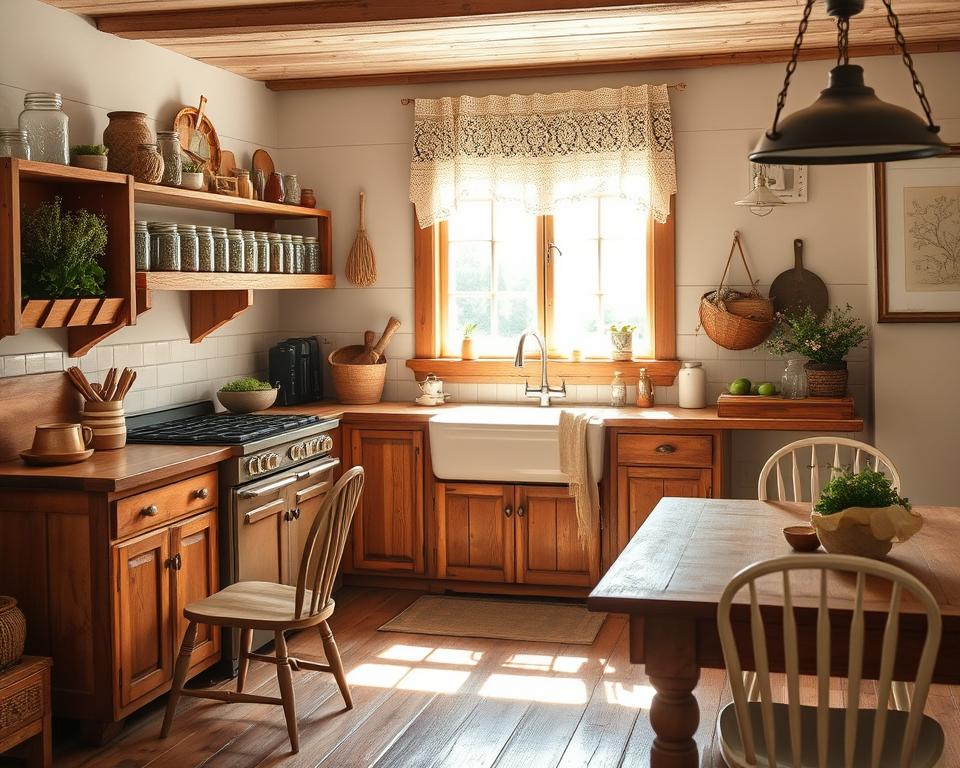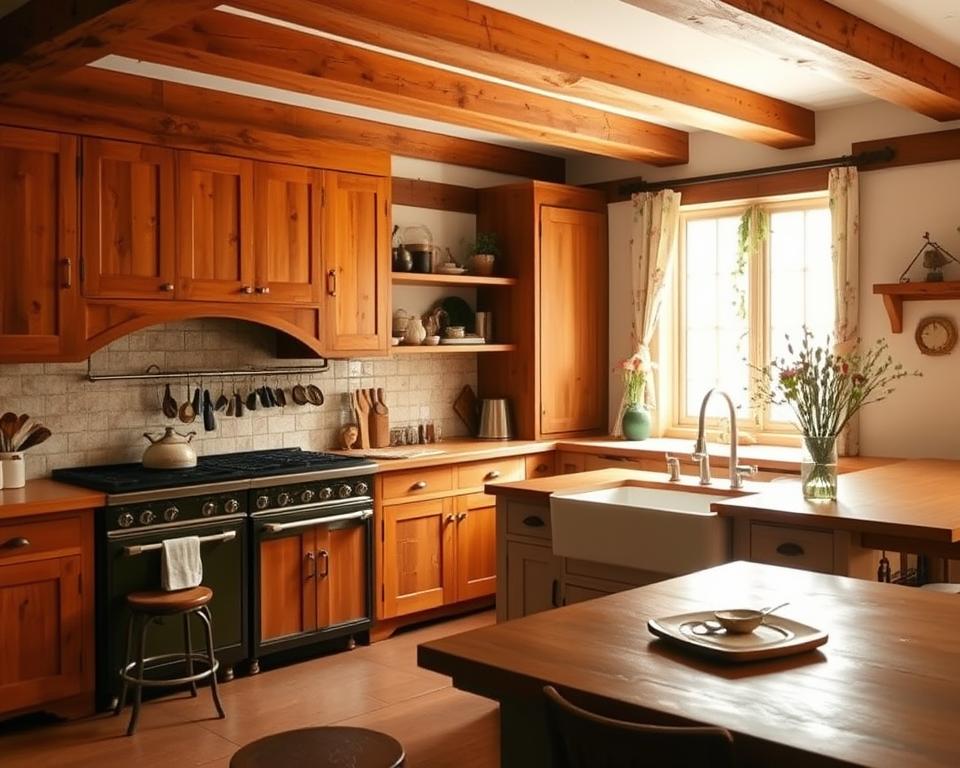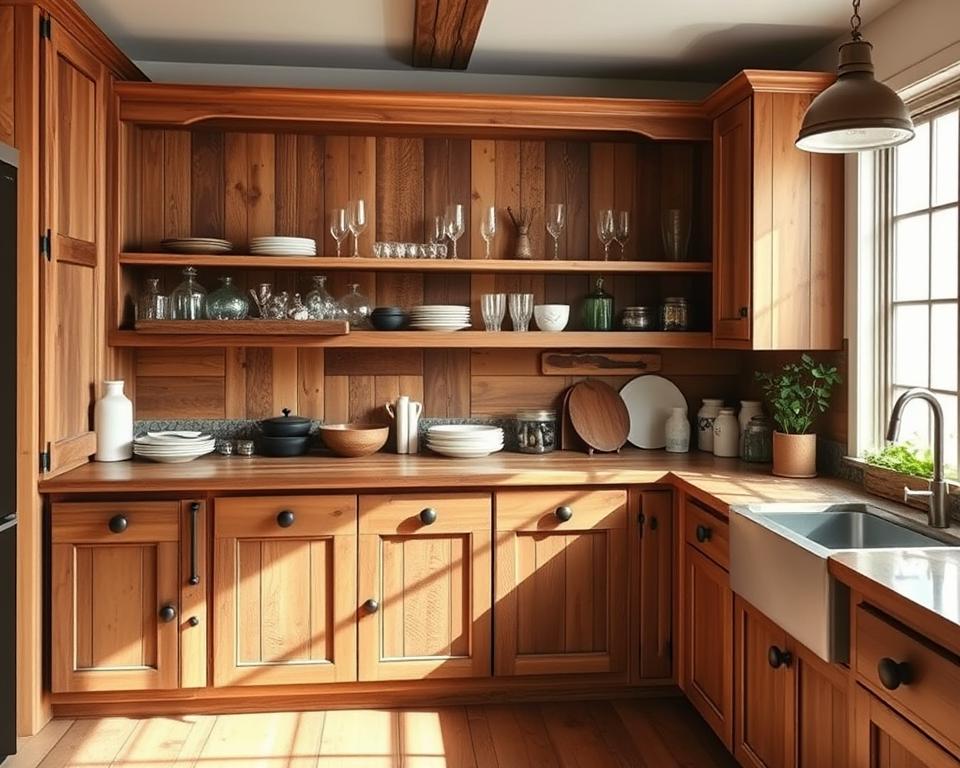Farmhouse kitchen design is about creating a warm, inviting atmosphere. It’s simpler than you might think to infuse your home with this country charm. By focusing on natural materials like wood and stone, and blending vintage with modern, you can craft a unique, cozy space. Ideal for both cooking and gathering, a modern farmhouse kitchen can feature custom white-and-blue cabinets. A rustic kitchen decor can be elevated with vintage oak chandeliers and reclaimed materials.
Adding farmhouse kitchen design elements, such as farmhouse tables and checkerboard flooring, brings country charm to your space. The popularity of farmhouse-style renovations is evident, with 70% of consumers favoring wood or stone countertops. Also, 60% of farmhouse kitchen designs include islands or large wooden tables. Whether aiming for a rustic kitchen decor or a modern farmhouse kitchen, there are numerous ways to infuse your home with countryside warmth and charm.
Key Takeaways
- Farmhouse kitchen design is all about creating a warm and inviting atmosphere
- Natural materials like wood and stone are key elements in farmhouse kitchen design
- Modern farmhouse kitchen and rustic kitchen decor can be achieved with unique design elements
- Farmhouse kitchen design is versatile and can be adapted to fit various kitchen sizes and budgets
- Incorporating vintage and reclaimed materials can add character and nostalgia to your kitchen
- Thoughtful lighting design is essential in creating an inviting atmosphere in farmhouse kitchens
Understanding the Essence of Farmhouse Kitchen Design
A farmhouse style kitchen embodies a warm, inviting atmosphere. This is achieved through natural materials and classic design elements. Homeowners often choose wooden accents, like beams and shiplap, to enhance the cozy, rustic feel.
In a farmhouse kitchen, cabinets are key to the aesthetic. They are designed for simplicity and functionality, with clean lines and a distressed finish. This adds to the rustic charm. Natural materials, such as wood and stone, contribute to the warmth and texture of the kitchen.
- Exposed wooden beams and shiplap paneling to add texture and visual interest
- Natural stone or brick accents to bring warmth and depth to the space
- Classic farmhouse kitchen cabinets with a distressed finish to add rustic charm
Incorporating these elements helps homeowners create a beautiful, functional kitchen. It’s perfect for cooking, entertaining, and making memories with family and friends.
| Design Element | Description |
|---|---|
| Exposed Wooden Beams | Add texture and visual interest to the kitchen |
| Natural Stone or Brick Accents | Bring warmth and depth to the space |
| Classic Farmhouse Kitchen Cabinets | Add rustic charm with a distressed finish |
Popular Farmhouse Kitchen Styles
Designing a farmhouse kitchen offers a variety of styles, each with its own distinct features. Modern farmhouse kitchens are known for their clean lines and focus on functionality. In contrast, rustic kitchens embrace vintage and distressed elements, like reclaimed wood, to foster a cozy ambiance.
The modern farmhouse style has seen a surge in popularity, thanks to shows like Fixer Upper. It blends modern and rustic elements, such as black hardware with white cabinets. Adding a farmhouse kitchen island enhances functionality, offering more counter space and storage. This style often incorporates natural materials and vintage-inspired decor.
Rustic and industrial farmhouse styles are also favored. Rustic kitchens often include shiplap, reclaimed wood, and vintage appliances. Industrial farmhouse kitchens feature metal stools, pendant lights, and exposed brick. The essence of a beautiful farmhouse kitchen lies in choosing a style that resonates with your taste. It’s about creating a space that feels warm and inviting.
Color Palettes for a Farmhouse Kitchen
In farmhouse kitchen design, the color palette is crucial for creating a warm, inviting atmosphere. Neutral colors like whites, grays, and beiges form the base, offering a versatile canvas for adding accent colors and textures. This approach ensures a harmonious blend of elements.
A farmhouse kitchen often features a farmhouse sink as a focal point. To enhance this, use earthy tones and neutrals for cabinets and walls. This combination fosters a serene, calming environment, ideal for a kitchen.
Popular colors for farmhouse kitchens include soft whites, warm beiges, and light grays. These hues can unify walls, cabinets, and countertops. Adding muted blues, greens, and rustic reds as accent colors introduces depth and personality.
Earthy Tones and Neutrals
Earthy tones like sage green and sandy beige add warmth and coziness. These colors can adorn walls, cabinets, or countertops, creating a natural, inviting space.
Accent Colors for a Pop of Personality
Bold reds and blues can inject personality into a farmhouse kitchen. Use these colors for accessories like rugs, towels, and decor to add a unique touch.
Choosing the Right Kitchen Layout
Designing a farmhouse kitchen requires careful consideration of the layout. A well-thought-out layout enhances both functionality and beauty. Even in small spaces, clever design can make the kitchen feel larger and more welcoming.
The layout of a farmhouse kitchen should prioritize both function and flow. A kitchen island is essential, acting as a workspace, storage area, and social center. In fact, 85% of modern farmhouse kitchens include an island, showcasing its vital role. A vintage farmhouse kitchen benefits greatly from an island, adding warmth and a nostalgic feel.
Popular layouts for a farmhouse kitchen include:
- Open concept: This layout removes barriers between the kitchen, living, and dining spaces, promoting socialization and creating a sense of openness.
- L-shaped: This layout offers versatility and maximizes space usage, making it suitable for both large and small homes.
- U-shaped: This layout provides extensive counter space and is beneficial in larger homes for maximizing storage.
A well-designed farmhouse kitchen island can also enhance the perception of space. Using natural materials like reclaimed wood and clever design elements, such as panel molding and open shelving, can create a vintage farmhouse kitchen that is both functional and stunning.
Essential Elements of Farmhouse Design
Creating a stunning and practical farmhouse kitchen design requires careful consideration of key elements. A farmhouse sink is crucial, bringing a nostalgic charm to the space. Also, farmhouse kitchen cabinets should be both simple and elegant, prioritizing functionality and durability.
For materials, natural elements like reclaimed wood, stone, and metal finishes are favored in farmhouse kitchen design. These can adorn countertops, cabinets, and flooring. For instance, a farmhouse sink can complement a reclaimed wood countertop and metal cabinets, achieving a unified look.
- Neutral color palette with soft whites, creamy beiges, and light grays
- Natural materials such as reclaimed wood, stone, and metal finishes
- Simple and elegant farmhouse kitchen cabinets
- A farmhouse sink with a nostalgic and charming appeal
By integrating these key elements, homeowners can craft a farmhouse kitchen design that’s both beautiful and functional. It’s ideal for cooking, entertaining, and creating lasting memories with loved ones.
| Element | Popularity | Description |
|---|---|---|
| Farmhouse Sink | 75% | A must-have for farmhouse kitchen design, adding a touch of nostalgia and charm |
| Reclaimed Wood | 65% | A popular choice for countertops, cabinets, and flooring, adding a natural and rustic touch |
| Shaker-Style Cabinets | 50% | A simple and elegant choice for farmhouse kitchen cabinets, focusing on functionality and durability |
Farmhouse Kitchen Decor Ideas
To craft a welcoming atmosphere in your farmhouse kitchen, consider vintage accessories and decorative elements. Vintage mason jars are a popular choice for storing dry goods, adding charm. Antique utensils and unique items can also personalize your space.
Farmhouse kitchens blend rustic charm with modern functionality. A farmhouse kitchen island enhances counter space and storage. Opt for a vintage-inspired island with a distressed finish to enhance your kitchen’s rustic appeal.
In a vintage farmhouse kitchen, every detail matters. Adding greenery, like an herb garden, brings natural beauty. Wall art and signage can also add a personal touch, making your kitchen welcoming. Popular decor ideas include:
- Using vintage-inspired lighting fixtures, such as metal pendant lights or glass chandeliers
- Incorporating natural materials, such as reclaimed wood or stone, into your kitchen design
- Adding decorative elements, such as vintage-style signs or antique utensils, to your kitchen walls and shelves
By incorporating these decor ideas, you can create a functional and beautiful space. Balance your decor with modern elements like sleek appliances and contemporary flooring. This will make your kitchen uniquely yours.
Lighting Solutions for Farmhouse Kitchens
Lighting is key in creating a warm, inviting atmosphere in farmhouse kitchens. A well-thought-out lighting plan can greatly enhance both the look and function of the space. In a modern farmhouse kitchen, options range from pendant lights over the island to ambient lighting, fostering a cozy feel.
In a rustic kitchen decor, vintage pendants and metal accents are favored, bringing a nostalgic charm. About 35% of farmhouse kitchen designs feature metal in lighting, complementing wood and fabrics. Pendant lighting is also a big trend, seen in around 60% of kitchens.
For a unique lighting plan, mix task, ambient, and accent lighting. This can include pendant lights, sconces, and chandeliers. These elements add interest and warmth, making your farmhouse kitchen design both functional and beautiful.
Some top lighting choices for farmhouse kitchens include:
- Pendant lights over the island
- Warm ambient lighting
- Vintage-style pendants
- Metal elements in lighting
These options help create a cozy, welcoming space in your farmhouse kitchen design. It becomes the ideal spot for cooking, entertaining, and bonding with loved ones.
Maximizing Storage in Farmhouse Kitchens
Storage is key in farmhouse kitchen design. A well-thought-out storage system greatly enhances both function and beauty. Open shelving is a favorite for its ease of access and rustic charm.
Clever cabinet designs also play a significant role. Custom cabinets can be tailored to fit specific needs, such as adjustable shelving. Free-standing cabinets, like vintage dressers or industrial metal units, offer unique storage options and adaptable layouts.
- Tall pantry units with painted wood finishes or glass-front doors
- Deep drawers and pull-out trays for maximum storage
- Open shelving for decorative displays and easy access to essentials
- Free-standing cabinets, such as vintage dressers or butcher block islands
By integrating these storage solutions, homeowners can craft a functional and stylish farmhouse kitchen. The right mix of cabinets, open shelving, and clever designs can achieve a kitchen that’s both chic and practical. Adding a farmhouse sink enhances the kitchen’s functionality and beauty, adding a rustic touch.
Sustainable Design Practices
In designing a modern farmhouse kitchen, it’s crucial to focus on sustainable practices. These not only cut down on waste but also enhance eco-friendliness. Incorporating reclaimed materials, like reclaimed wood, brings warmth and character to the space. Energy-efficient appliances are also vital, as they significantly lower energy use.
Implementing sustainable kitchen design involves using reclaimed materials, energy-efficient appliances, and low-flow faucets. These steps help in reducing waste, promoting sustainability, and improving indoor air quality. For instance, energy-efficient refrigerators consume up to 40% less energy than older models. Low-flow faucets can also save up to 30% of water usage.
Using natural materials, such as bamboo, adds warmth and character. Bamboo, being highly renewable, is an ideal choice for countertops and cabinets. By embracing sustainable design, homeowners can craft a modern farmhouse kitchen that’s both stunning and eco-conscious.
| Sustainable Practice | Benefits |
|---|---|
| Reclaimed Materials | Reduces waste, promotes sustainability |
| Energy-Efficient Appliances | Reduces energy consumption, saves money |
| Low-Flow Faucets | Saves water, reduces waste |
DIY Projects for a Farmhouse Touch
Embarking on a farmhouse kitchen makeover? Don’t shy away from DIY projects. Upcycling vintage furniture and crafting custom decor can bring authentic farmhouse charm to your space. These ideas will help you create a kitchen that fits any size, budget, and style.
Transform an old dresser or cabinet into a unique kitchen island. Add a butcher block countertop or a farm-inspired sink for a touch of elegance. Use reclaimed wood planks for open shelving to display your favorite cookware and personal items. A few coats of paint and some distressing can give old furniture a new farmhouse look.
Creating custom decor like wooden signs, chalkboard menu boards, or rustic lighting can complete your kitchen’s farmhouse feel. Embrace DIY and let your creativity flow. Turn everyday items into unique pieces that showcase your style. These homemade touches will make your kitchen stand out with its own character.
FAQ
What is farmhouse kitchen design, and how can it bring country charm to any space?
What are the key elements that define farmhouse kitchen design?
What are the different styles of farmhouse kitchens?
What color palettes are commonly used in farmhouse kitchens?
How do you choose the right kitchen layout for a farmhouse kitchen?
What are the essential elements that make up a farmhouse kitchen design?
What are some farmhouse kitchen decor ideas?
What lighting solutions work well in a farmhouse kitchen?
How can you maximize storage in a farmhouse kitchen?
What sustainable design practices can be incorporated into a farmhouse kitchen?
What DIY projects can be used to add a farmhouse touch to the kitchen?

Chris Davis is a writer at TrendGaping, passionate about farmhouse decor and the beauty of rustic minimalism. With a keen eye for design and craftsmanship, he explores topics ranging from reclaimed wood furniture to timeless interior aesthetics. His goal is to inspire readers with creative and practical ideas for bringing warmth and authenticity to any space.



